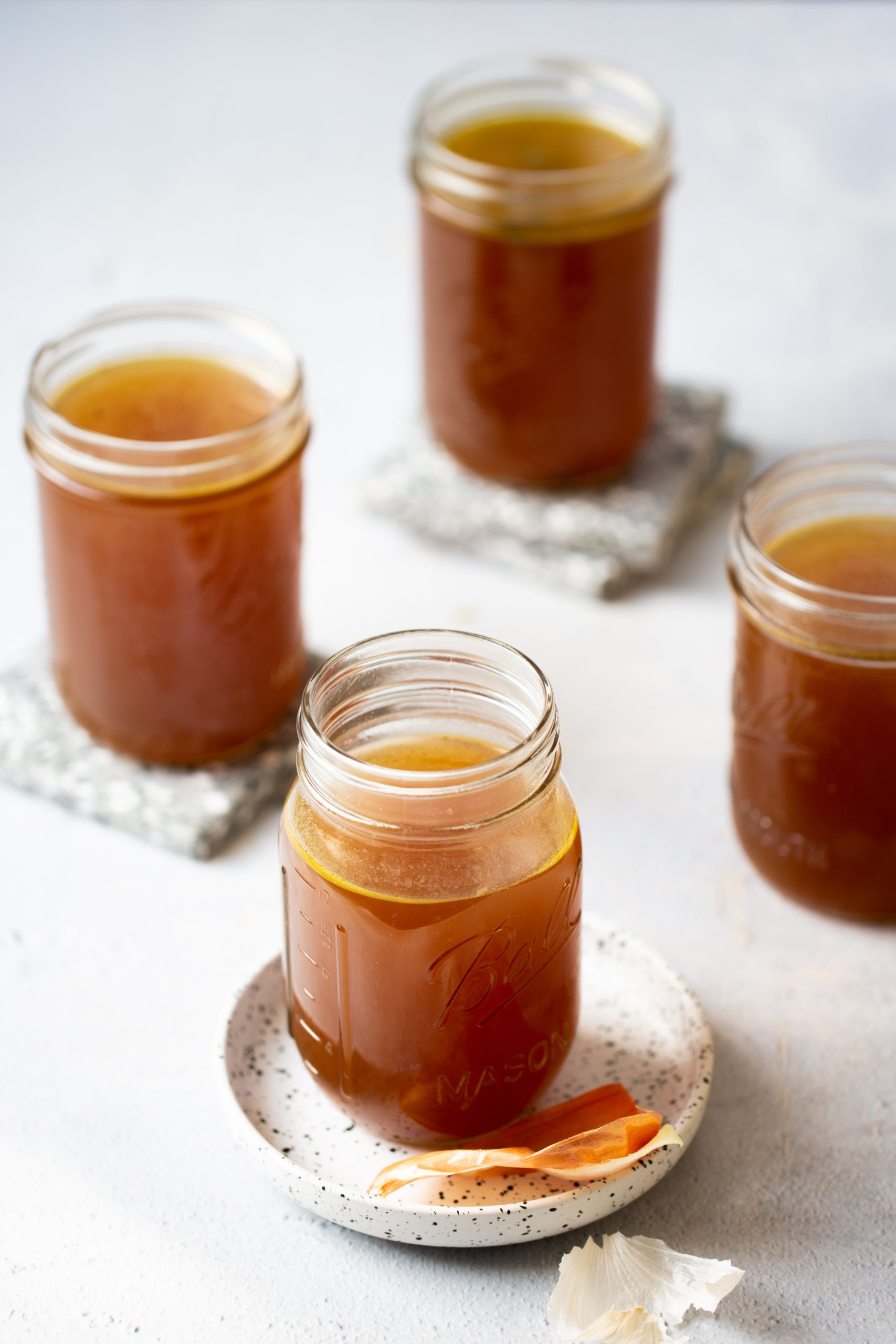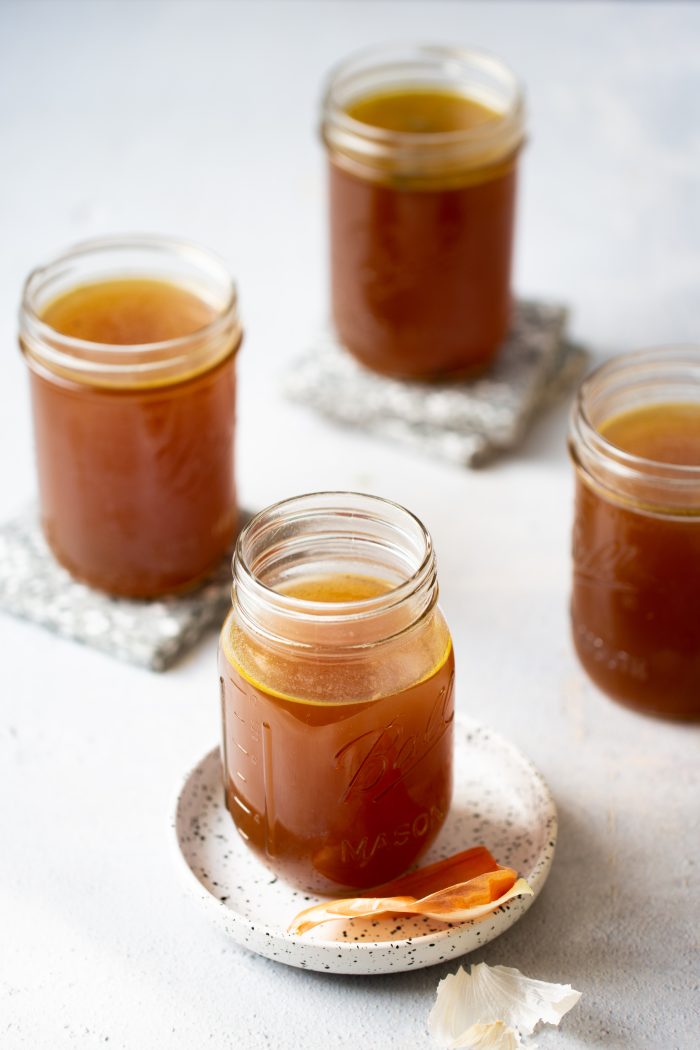
There is no wrong way to make homemade vegetable broth from scraps; it always comes out delicious and is a great way to use whole veggies. Also, ensuring that you get the maximum amount of flavor and utility out of the food you eat is a great way to ensure that your cash stretches as far as possible in the kitchen.
On top of that, you know precisely what you’ve put into your stock, so you won’t have to worry about allergens or any unhealthy additives and preservatives.
What you need to make vegetable broth
- Veggie scraps: Every time you start cooking, save the veggie scraps in a freezer-safe bag or freezer-safe container. You can save carrot tops and peels, onion, garlic, and shallot peels and tops.
- Celery, mushroom, herb (parsley, rosemary, bay leaf, oregano, etc.) stems, leek tops, and bottoms. You could also add greens like kale, cabbage, cauliflower, or broccoli greens.
- The possibilities are endless.
How to make the best homemade vegetable broth from scraps
From flavor to health to saving cash, making your stock is an excellent idea for your kitchen. Here are the basic steps to give it a go, along with some pointers.
Collect kitchen scraps. First, you’ll need to collect any vegetable scraps from your cooking. This can be almost anything, from seeds to stalks to cores to roots.
The most common thing is skins, such as carrots or another root veg.
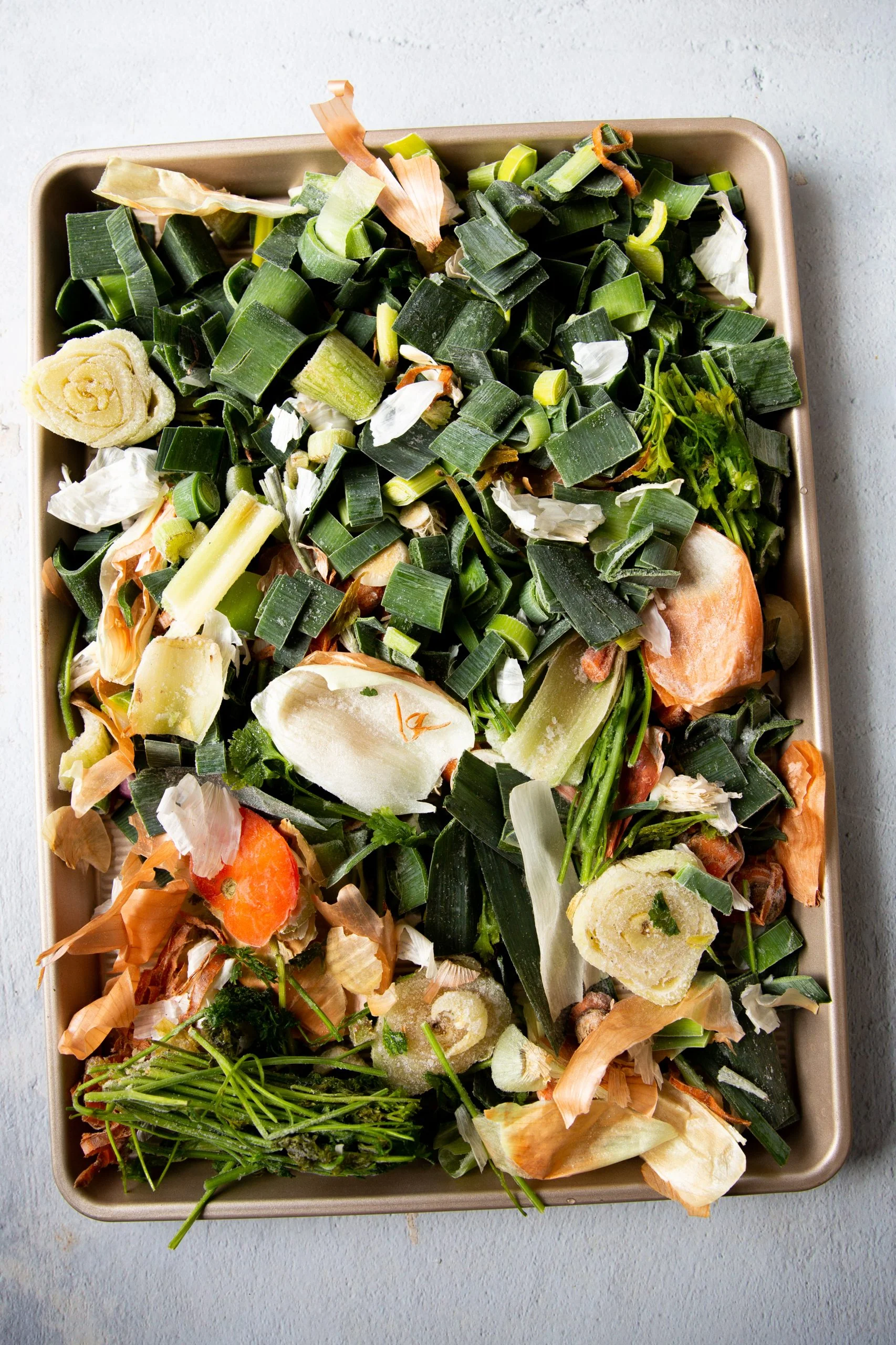
Roast your frozen scraps in the oven. Next, add all the scraps into a pan in the oven. I recommend going for roughly 400˚F for twenty minutes or so.
Toss your scraps with olive oil or other vegetable oil and some salt (I use kosher salt) before roasting to impart a little extra flavor.
Let them roast until golden but don’t forget to move the scraps around from time to time and rotate the baking sheet.
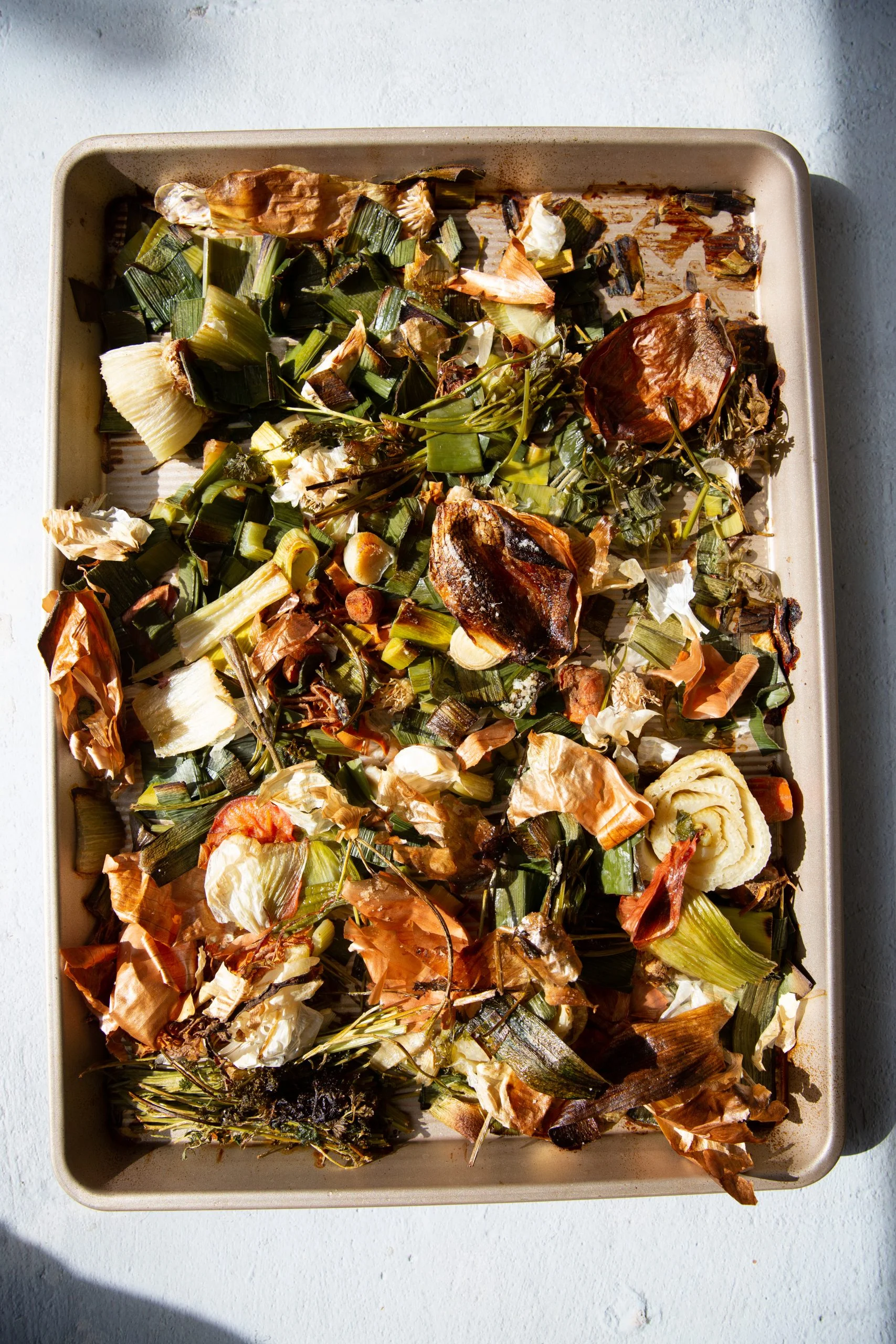
Boil and simmer. Now, add all the roasted scraps to a large stockpot. It doesn’t have to be a large specialist stockpot, but having something tall like a large Dutch oven or a pasta pot will do.
Using roughly one cup of water per cup of scraps, bring the mixture to a boil before reducing it to a simmer.
A simmer will allow the flavor to seep into the liquid without too much water immediately dissolving.
Ensure the lid is cracked slightly, as this will prevent the pot from boiling.
Let it simmer for 30 to 60 minutes to get the most flavor.
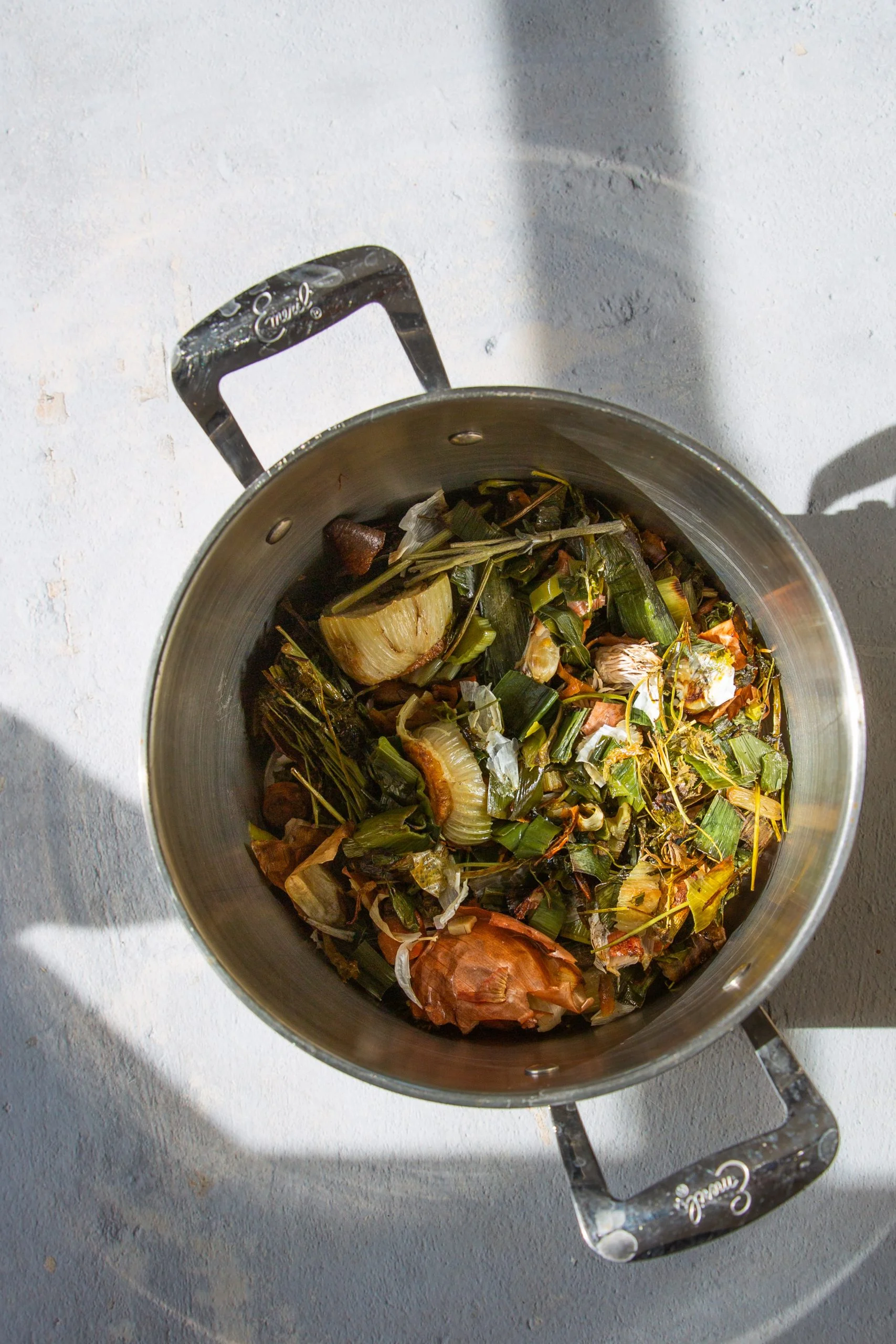
STRAIN THE SOLIDS. Now, strain the solids out of your stock. A handy way to do this is to use another pot to catch the liquid you’re pouring, with a fine mesh strainer colander or sieve intercepting the solids.
Expert tips on making vegetable broth
It’s essential, though, not to use potatoes. Making stock with potatoes produces a mealy texture and a poor finished product.
The best idea is to collect your scraps in a large container in your freezer. Move on to step two, which is to start making your vegetable broth when it’s full.
Be careful of herbs like thyme; the leaves can slip through sieves with larger holes.
Add tomato scraps, soy sauce, or mushroom stems if you want more flavor in the broth.
I use approximately 2 cups of water for every pound of solids, such as scraps.
How to Use Your Homemade Vegetable Broth
- You can use it as your liquid for cooking brown rice or quinoa.
- Make vegetable soup or lentil soup, or use it as your liquid to cook broccoli for a simple broccoli soup.
- You can also cook your legumes in it, which will be flavorful and delicious.
- Make noodles, miso, risotto, really, any recipe that calls for water or broth; you can use it.
Store or preserve the broth
Once the solids are out, your stock is ready to go! I suggest keeping a portion in the fridge for the next time you need to use it and then storing the rest for future use. A great way to do this is to freeze the stock in pint-sized portions, used one by one.
You could use mason jars if you keep them in the fridge or freezer bags to freeze them. I don’t freeze liquids in jars because I have not had a good experience with them; they usually break.
Alternatively, you could can your stock, though this is trickier. You’d need to use a pressure cooker or canner, as the content of the can has no acid or preservatives to inhibit bacterial growth. Using a tutorial and a pressure cooker, you can create a stock that can last for an extremely long time in a shelf-stable form.
HOMEMADE VEGETABLE BROTH FROM SCRAPS
Equipment
- Soup pot
Ingredients
- Vegetable scraps
Instructions
- Collect kitchen scraps. First, you’ll need to collect any vegetable scraps from your cooking. This can be almost anything, from seeds to stalks to cores to roots.The most common thing is skins, such as carrots or another root veg.
- Roast your frozen scraps in the oven. Next, add all the scraps into a pan in the oven. I recommend going for roughly 400˚F for twenty minutes or so.Toss your scraps with olive oil or other vegetable oil and some salt (I use kosher salt) before roasting to impart a little extra flavor.Let them roast until golden but don’t forget to move the scraps around from time to time and rotate the baking sheet.
- Boil and simmer. Now, add all the roasted scraps to a large stockpot. It doesn’t have to be a large specialist stockpot, but having something tall like a large Dutch oven or a pasta pot will do.Using roughly one cup of water per cup of scraps, bring the mixture to a boil before reducing it to a simmer.A simmer will allow the flavor to seep into the liquid without too much water immediately dissolving.Ensure the lid is cracked slightly, as this will prevent the pot from boiling.Let it simmer for 30 to 60 minutes to get the most flavor.
Notes
- Once the solids are out, your stock is ready to go! I suggest keeping a portion in the fridge for the next time you need to use it and then storing the rest for future use. A great way to do this is to freeze the stock in pint-sized portions, used one by one.
- You could use mason jars if you keep them in the fridge or freezer bags to freeze them. I don’t freeze liquids in jars because I have not had a good experience with them; they usually break.
- Alternatively, you could can your stock, though this is trickier. You’d need to use a pressure cooker or canner, as the content of the can have no acid or preservatives to inhibit bacterial growth. Using a tutorial and a pressure cooker, you can create a stock that can last for an extremely long time in a shelf-stable form.
Nutrition
information
Nutritional information of this recipe is only an estimate, the accuracy for any recipe on this site is not guaranteed.
- Peach Scones: A Delicious and Easy Recipe - July 24, 2024
- Panzanella inspired Pan Fried Gnocchi Salad - July 22, 2024
- Chickpea Vegan Ceviche - July 19, 2024
